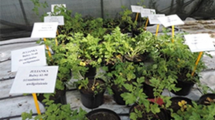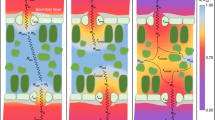Abstract
Comparative methods for measuring water potential in leaves and tubers of potatoes (Solarium tuberosum L., var. Russet Burbank) are described.
For leaves drier than -3 bars, the pressure chamber gave estimates of water potential which were zero to three bars drier than potentials measured using thermocouple psychrometers. Pressure chamber readings ranged ±2.5 bars from psychrometer value for leaves wetter than -3 bars; the psychrometer measurement usually was drier than the pressure chamber when leaves were sampled in the evening.
With tubers, water potential measurements usingin situ psychrometers and the pressure chamber agreed to within one bar,except in tubers drier than -7 bars, where there were discrepancies of± 2.5 bars. However, if the interval between psychrometer insertion and water potential measurement were longer than 24 hours, serious errors arose in the psychrometer measurements, apparently from suberization of tissues surrounding the psychrometers which prevented vapor equilibrium.
Pressure chamber measurements of tubers also were compared with tuber water potentials determined from the weight changes of tuber samples immersed in graded sucrose osmotica. For tubers wetter than -5 bars, the osmotica method gave drier estimates than the pressure chamber; for tubers drier than -5 bars the reverse occurred. Causes for these discrepancies are discussed.
Resumen
Se describen métodos comparativos para medir potenciales de agua en hojas y tubérculos de papa (Solanum tuberosum L., var. Russet Burbank).
Para hojas contenidos de humedad menores que -3 bars, la cámara de presión dió estimados de potenciales de agua que estuvieron entre cero y tres bars por debajo de los potenciales medidos usando psicómetros de termocupla. Las lecturas de la cámara de presión se desviaron± 2.5 bars de los valores del psicómetro para hojas más húmedas que -3 bars; las medidas del psicómetro dió contenidos de humedad más bajos que la cámara de presión cuando las muestras de hojas se tomaron al anochecer.
En tubérculos, las demidas del potencial de agua usando psicómetros en situ y la cámara de presión concordaron dentro del limite de 1 bar, excepto en tubérculos con humedad menor que -7 bars, donde hubieron discrepancias de ± 2.5 bars.
Sin embargo, si el intervalo entre la inserción del psicómetro y la medida del potencial de agua fue mayor de 24 horas, serios errores surgieron en las medidas del psicómetro, aparentemente debido a la suberización de tejidos alrededor del psicómetro, impidiendo así al equilibrio del vapor.
Las medidas de la cámara de presión para tubérculos también se cómpararon con potenciales de agua determinados por el cambio de peso de las muestras de tubérculos sumergidos en soluciones osmóticas de sucrosa. Para tubérculos con contenidos de humedad mayores que -5 bars, el mético dio estimados de humedad más bajos que la cámara de presión; lo opuesto ocurrió en tubérculos menos húmedos que -5 bars. Se discuten las causas de estas discrepancias.
Similar content being viewed by others
Literature Cited
Ashby, E. and R. Wolf, 1947. A critical evaluation of the gravimetric method of determining suction force. Ann Bot N.S. 11: 261–268.
Barrs, H. D., B. Freeman, J. Blackwell, and R. D. Ceccato. 1970. Comparisons of leaf water potential and xylem water potential in tomato leaves. Aust J Biol Sci 23: 485–487.
Baughn, J. W. and C. B. Tanner. 1976a. Leaf water potential: comparison of pressure chamber andin situ hygrometer on five herbaceous species. Crop Sci (In press).
Baughn, J. W. and C. B. Tanner. 1976b. Leaf Water potential: excision effects in measurements on five herbaceous species. Crop Sci (In press).
Borchert, R. and J. D. McChesney. 1973. Time course and localization of DNA synthesis during wound healing of potato tuber tissue. Dev Biol 35: 293–301.
Borchert, R., J. D. McChesney, and D. Watson. 1974. Wound healing in potato tuber tissue. Phosphon inhibition of developmental processes requiring protein synthesis. Plant Physiol 53: 187–191.
Boyer, J. S. 1967. Leaf water potentials measured with a pressure chamber. Plant Physiol 42: 133–137.
Boyer, J. S. 1968. Relationship of water potential to growth of leaves. Plant Physiol 43: 1056–1062.
Burstrom, H., 1965. Definition and determination of water saturation. Protoplasma 61: 294–301.
Campbell, G. S. and M. D. Campbell. 1974. Evaluation of a thermocouple hygrometerfor measuring leaf water potential insitu. Agron J 66: 24–27.
Campbell, M. D. 1972. The lower limit of soil water potential for potato growth. Ph.D. Thesis, Washington State Univ. 49 p. Univ. Microfilms, Ann Arbor, MI. (Diss. Abstr. Int. 33: 2885B).
Carlier, A. and K. Buffel. 1955. Polysaccharide changes in the cell walls of water absorbing potato tuber tissue in relation to auxin action. Acta Bot Neerl 4: 551–564.
Davis, W. C., D. J. Le Tourneau, M. V. Zaehringer, and H. H. Cunningham. 1973. Leaching of solutes and sloughing of potato tuber tissue. Am Potato J 50: 35–41.
Dessimoni, Pinto C. M. and T. J. Flowers. 1970. The effects of water deficits on slices of beetroot and potato tissue. II. Changes in respiration and permeability to solutes. J Exp Bot 21: 754–767.
Ehlig, C. F. 1962. Measurement of the energy status of water in plants with a thermocouple psychrometer. Plant Physiol 37: 288–290.
Epstein, E. and W. J. Grant. 1973. Water stress relations of the potato plant under field conditions. Agron J 65: 400–404.
Flowers, T. J. and C. M. Dessimoni Pinto. 1970. The effects of water deficits on slices of beetroot and potato tissue. I. Tissue-water relationships. J Exp Bot 21: 746–753.
Gandar, P. W. 1975. Growth and water relations in potatoes (Solanum tuberosum L.). Ph.D. Thesis, Univ. of Wisconsin, Madison. 185 p. Univ. Microfilms, Ann Arbor, MI. (Diss. Abstr. Int. [to be published]).
Gandar, P. W. and C. B. Tanner, 1976. Potato leaf and tuber water potential measurements with a pressure chamber. Am Potato J (In press).
Kolattukudy, P. E. and B. B. Dean. 1974. Structure, gas Chromatographic measurement, and function of suberin synthesized by potato tuber tissue slices. Plant Physiol 54: 116–121.
Laties, G. G. 1967. Metabolic and physiological development in plant tissues. Aust J Sci 31: 193–203.
Merrill, S. D. and S. L. Rawlins. 1972. Field measurement of soil water potential with thermocouple psychrometers. Soil Sci 113: 102–109.
Meyer, B. S. and A. T. Wallace. 1941. A comparison of two methods of determining the diffusion pressure deficit of potato tuber tissues. Am J Bot 28: 838–843.
Millar, B. D. 1974. Improved thermocouple psychrometer for the measurement of plant and soil water potential. III. Equilibration. J Exp Bot 25: 1070–1084.
Richards, H. M. 1897. The evolution of heat by wounded plants. Ann Bot 11: 29–63.
Sale, P. J. M. 1973. Productivity of vegetable crops in a region of high solar input. I. Growth and development of the potato (Solanum tuberosum L.). Aust J Agric Res 24: 733–749.
Shepherd, W. 1973. Plant moisture status effects in estimation of evaporation by a combination method. Agric Meteorol 11: 213–222.
Slatyer, R. O.1966. An underlying cause of measurement discrepancies in determinations of osmotic characteristics in plant cells and tissues. Protoplasma 62: 34–43.
Stegman, E. C. and D. C. Nelson. 1973. Potato response to moisture regimes. North Dakota Res. Rep. No. 44, North Dakota State Univ., Fargo. 15 p.
Thimann, K. V., G. M. Loos, and E. W. Samuel. 1960. Penetration of mannitol into potato discs. Plant Physiol 35: 848–853.
Tinklin, R. 1967. Note on the determination of leaf water potential. NewPhytol 66: 85–88.
Werner, H. O. 1947. Commercial potato production in Nebraska. Nebr Agric Exp Stn Bull 384, 173 p.
Author information
Authors and Affiliations
Additional information
Contribution from the Department of Soil Science, University of Wisconsin. Research supported by the College of Agricultural and Life Sciences, University of Wisconsin, Madison, Wisconsin, 53706, and by USDA Hatch funds.
Rights and permissions
About this article
Cite this article
Gandar, P.W., Tanner, C.B. Comparison of methods for measuring leaf and tuber water potentials in potatoes. American Potato Journal 52, 387–397 (1975). https://doi.org/10.1007/BF02852793
Received:
Issue Date:
DOI: https://doi.org/10.1007/BF02852793




